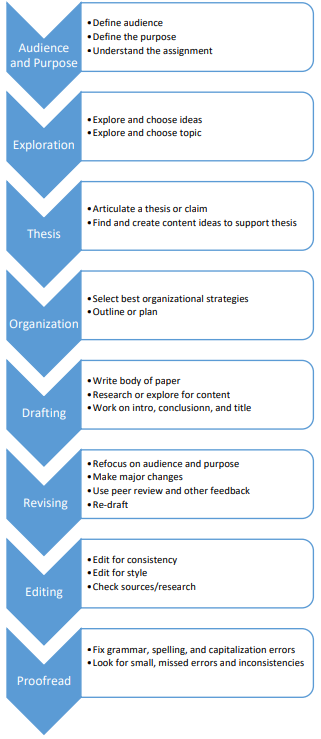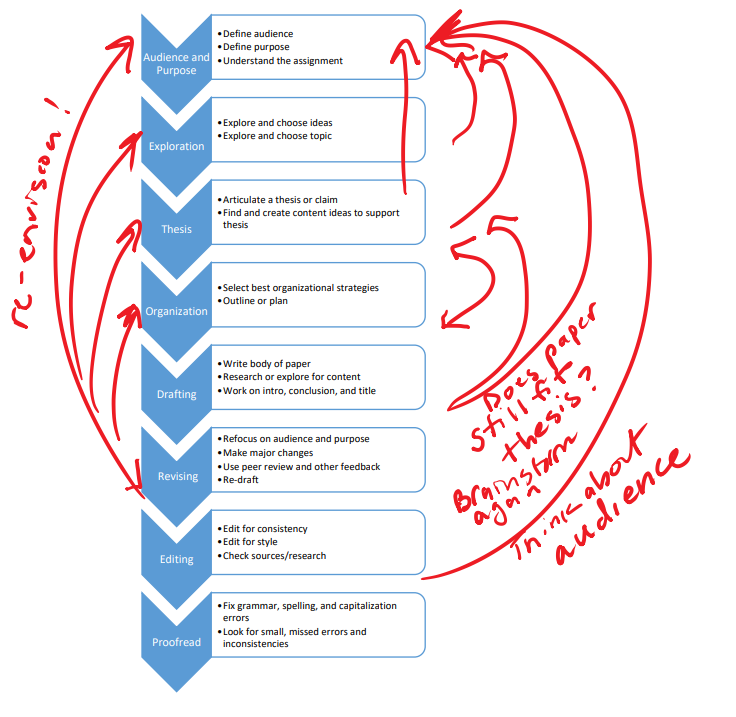2.2: The basic writing process chart
- Page ID
- 25372
The basic writing process chart

These steps are the basics of a writing process, and the process looks pretty clear. However, each writer will spend different amounts of time on the process. Also, writing isn’t this linear. Sometimes it looks more like:

As you can see, the process goes back and forth. Writers might have a thesis and organization and begin drafting. Then they might realize the thesis isn’t working, so they go back and revise the thesis. Then the organization will need to change, too. Once the draft is done, the introduction and conclusion might need to be rewritten because they no longer address the audience and purpose.
When revising, writers should be going back to all of the previous parts of the process: thinking about whether the writing meets audience and purpose, whether the thesis still holds true, if the organization is still working, if the style is still clear and consistent.
Revising sometimes means scrapping everything and starting over.
All writers have a process.
Let’s look at an example, something we do all the time, like writing a grocery list. Even writing a grocery list is a process:
- Who is the audience? Is this for me or someone else? That informs other decisions.
- What is my purpose? Do I want a huge shopping trip, multiple stops or a short in and out?
Once audience and purpose have been thought through, the following steps might be taken:
Exploration: What do I need? Make a list.
Thesis: Create a heading that leads the audience to the goal. Are you shopping for a major event like a party? Are there specific needs of your guests (vegetarian, gluten free)?
Organization: Redo the list based on organization (for a grocery store, it might be how the store is laid out: grocery, meat, canned goods, condiments, dairy, bread). Your goal is efficiency. Get in, get the stuff, get out.
Draft: Write the list in the organizational format chosen.
Revise: Look it over. Is it legible? If the audience is someone else, will they understand what it all means? Did you miss anything? Do you need checkboxes? Do you need to add specific brands, types, or descriptions? Kraft Macaroni and Cheese, not generic?

Edit: Are the spelling and words consistent and clear?
Proofread: Check to make sure everything is there.
Throughout the rest of this book, this process, shown simply in the example above, will be explored and explained in detail.
In writing, the trick is to find your process, to see what you do and how you do it.
Think about the kind of writer you are.
What kind of writer are you?
- Are you a sprinter?
Do you have lots of ideas and want to get to them quickly?
If so, you probably skip to drafting and spend a lot of time on revising.
Try spending more time on the start of the writing process. Spend more time on defining audience and purpose and on exploring and planning. Then revising might not be a Herculean task.
- Are you a jogger?
Do you try to go through the writing process one step at a time?
Maybe some parts are harder than others, like organization or writing a thesis?
Try new strategies for those parts of the writing process that are most difficult. If revision is hard, get lots of feedback and learn to critique others. If audience and purpose make no sense, spend some time looking at how other writers bend their writing to their audiences and purpose.
- Are you a tightrope walker?
Do you want everything to be perfect before you set it down on paper?
Are you a perfectionist? If so, you probably spend a lot of time at the start of the writing process but have more trouble with revising.
Try being willing to make changes in revision based on looking at organization, audience and purpose. Is everything in the paper really working together? Don’t be afraid to get rid of parts and start over.


